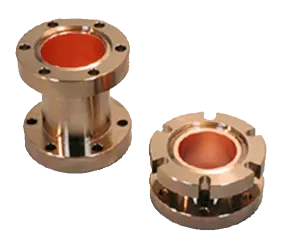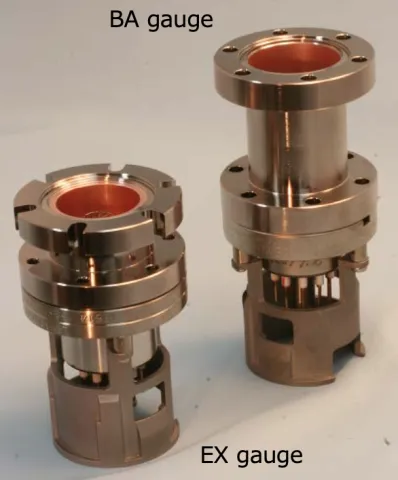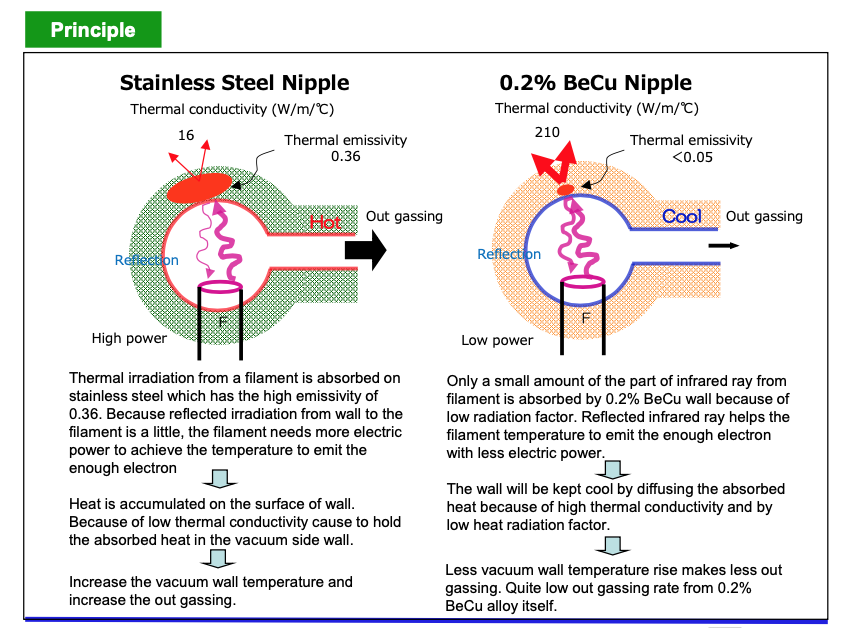Easily fit your nude B-A gauge or EX gauge onto the Magic Nipple to improve vacuum pressure without the hassle.

- 0.2% BeCu alloy material (No welding)
- Outgas from a gauge reduced to 1/7
- Base pressure can be improved one decade
- Power consumption reduced to 1/2 or less
- NiP treatment on Copper surface
- Maximum baking temperature 300°C
- Standard Cu gasket can be used, or silver coated Cu gasket for over 250°C
Outgassing data
| Outgassing speed | With magic nipple | With st. steel nipple | |
|---|---|---|---|
| BA Gauge (1/4 reduction) | 2.1x10-11 Pa · m3/s | ⇐ | 8.9x10-11 Pa · m3/s |
| EX gauge (1/7 reduction) | 5.6x10-12 Pa · m3/s | ⇐ | 3.9x10-11 Pa · m3/s |
After 200°C, 2 hours bake out + 18 hours pumping. Measured with throughput method.


About the Magic Nipple
The “magic nipple” is a unique product developed by our company that utilises the properties of 0.2% BeCu alloy materials.
Hot cathode ionization gauges such as the BA gauge are often large gas sources in extreme-high vacuum environments. If you touch near the gauge port when the gauge is on, it should be quite hot. Inside is much hotter. Everyone has probably thought at one time “I want to disconnect the hot cathode ionization gauge to get a lower vacuum” . However , without the vacuum gauge it is not possible to know the vacuum inside. There is no real option, and most people probably give up.
In this kind of situation, you should try the “magic nipple”. If you insert the BAG or EXG that you are using into the “magic nipple” and then attach it to a stainless steel gauge port, then the gas emissions from the vacuum gauge will decrease as if by magic despite having done nothing to the vacuum gauge itself. The trick is the large difference (complete reversal) of emissivity and thermal conductivity of the 0.2% BeCu alloy from our company compared to stainless steel (also applies to titanium).
Stainless steel (and titanium) has an extremely large absorptance of radiation (infrared to visible light) and absorbs around 36% of radiation at the surface from single reflections. Since the grid and filament of a gauge are made from thin wires, the probability of striking the wall is much larger than the probability of striking this wire material, and the radiation is absorbed completely after around 7 to 8 reflections. As a result, the filament is constantly cooling due to the radiative heat continuously emitted from the filament, and a large amount of power is required to heat the filament.
Furthermore, stainless steel and titanium have the poorest heat conduction among the vast diversity of metals. Therefore, once heat has been absorbed, it is difficult for it to escape, and the temperatures of the vacuum pins, flange, etc. increase, and gas emissions increase as a result.
When the gauge is enclosed in the “magic nipple” which is made from 0.2% BeCu alloy material, the radiation from the filament is reflected from the wall surfaces at a proportion of 97% (polishing the walls to a mirror surface is even more effective). The amount of radiation that undergoes 100 or more reflections and then bombards the filament again also increases.
In fact, when an ammeter and voltammeter are connected to the vacuum pins of the gauge and the magic nipple is compared to stainless steel, the magic nipple is found to reduce the power consumption to 1/3.
Since the heat that is conducted to the vacuum pins, flange, etc. is quickly dispersed to the nipple side due to the high thermal conductivity of copper, gas emissions from the vacuum pins and flange are greatly suppressed.
The four metals gold, silver, copper, and aluminum feature extremely small emissivity (absorptance) of at least 3% with thermal conductivities that are 13 to 25 times larger. By using this property, it is possible to drastically reduce the gas emissions from a hot cathode gauge. Gold and silver cannot be used to fabricate gauge ports. Aluminum is too soft and the mismatch in the coefficient of thermal expansion is a major practical problem. Although copper has the most potential, it also has the weakness of being soft enough that it is used in gaskets.
This is solved by the 0.2% BeCu alloy extreme-high vacuum structural material developed by our company. This alloy can achieve the lowest gas emission rates among practical materials by performing special surface passivation treatment. It offers thermal conductivity virtually the same as pure aluminum with greater hardness than stainless steel, and its thermal expansion coefficient is the same as that of copper and stainless steel.
This offers high reliability vacuum seals that can withstand high temperature baking with existing stainless steel components that use copper gaskets for typical Conflat seals. As a result, when a gauge port is fabricated using this material, the gas emissions can be greatly reduced with a single nipple.